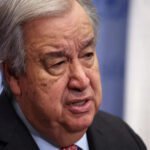By Dr. Gyan Pathak
Following the shocks of the last five years, global fragility remains at a near-record high level. The diversity of fragility profiles, according to the States of Fragility 2025 report, across all contexts is striking. About 2.1 billion people, or 25 per cent of the world’s population are living in context with high and extreme fragility in 2025. This figure is projected to grown to 2.3 billion by 2030 and 3.2 billion by 2050.
This recently released OECD report says that the most severe impact of fragility is observed in the 61 contexts experiencing extreme or high fragility. The region where it is most severe is home to 72%of the extreme poor (2024), which could surge to 92% by 2040.
States of Fragility 2025 warns that violence of all types is rising as support for prevention diminishes. Fragility increased most in the political, security and economic dimensions, driven by geopolitical competition, the race for energy security, rising debt and an increased willingness to use violence of all kinds.
The number of armed conflicts is at its highest since the end of the Cold War. Armed conflict is concentrated in contexts with the highest exposure to fragility: Sudan, the Great lakes region, the Sahel and West Africa and Myanmar.
Of the 61 contexts with high and extreme fragility, 24 are experiencing armed conflict and 8 are in a state of war. Beyond armed conflict, multi-layered trends on violence – increased non-state violence, violence against women, high homicide rates and the role of organised crime in and outside of conflict-affected areas – highlight the necessity of preventative action on violence. However, resources for peace and conflict prevention in contexts facing high and extreme fragility are at their second lowest level since 2004.
Looking at a fragmented and disordered world through a fragility lens gives the impression of a state of geopolitical flux, with no truly dominant actors – autocracies are not as resilient as often assumed, and many democracies are investing less and less in their resilience capacity, particularly in state institutions, checks and balances.
The report says that fragility Across Africa and the Middle East, is being instrumentalised for political, economic and security ends, often reversing development gains. State and non-state actors are analysing the sources of risk and resilience that shape fragility – not as challenges to address but as situations to leverage and exploit as part of local and global strategies.
Global trade has repeatedly been disrupted in recent years, first by the COVID-19 pandemic, then by Russia’s attack on Ukraine, a major grain exporter, and in 2024 by the Red Sea shipping crisis – a precipitous drop in the volume of traffic through the Suez Canal and Bab El-Mandeb Straight due to outright attacks on commercial vessels.
Decades of relative prosperity have been an important source of resilience for much of the world, but the kind of growth that brings widespread poverty reduction has proven much harder to achieve in contexts exposed to high and extreme fragility. Incomes in these contexts stopped catching up with advanced economies around 2015, and post COVID have settled at negative growth (in contexts with extreme fragility) and around 2% (in contexts with high fragility). Debt sustainability and fiscal fragility have become even more challenging since 2022, constraining the ability to respond to shocks or invest in the future.
Global demographic growth is concentrated in contexts with high to extreme fragility. Youth (ages 15-24) account for one out of every five people in context of high and extreme fragility. On average, 27 per cent of the youth population in these contexts are not in employment education and training.
Youth in these contexts are increasingly digitally connected, politically active and open to engagement on their futures: a political force to be harnessed by whoever provides the most convincing narrative; in most cases, their needs and expectations are being frustrated. They are also vulnerable to misinformation, disinformation and violence, and limited by poor health and education opportunities and gender divides.
The report says that the ways and means of engaging with youth in contexts with high and extreme fragility needs to change. Short term engagements can be ineffective where other actors are offering hard incentives to migrate (illegally), join militias or organised criminal groups, or act as disruptive agents for one political entity or another. Failing to engage more substantively with youth populations in contexts with high and extreme fragility risks turning the potential for a demographic dividend into liability. Where risks of poverty, violence, disfranchisement and inequality, notably gender inequality, intersect, incentivising positive, attractive and competitive pathways for young populations is priority for effective development and conflict prevention.
Nevertheless, the report is optimistic. It says that even in contexts with extreme fragility progress is possible and development assistance can be effective. Positive signs in Iraq and Somalia demonstrate that sustained engagement across humanitarian, development and peace pillars can foster progressive change.
However, the report warns, in many other contexts with extreme fragility, longstanding development gaps, high levels of poverty, and political vacuums persist. This has geopolitical consequences: competing national and international actors are often quick to establish their influence and models for short-term, transactional, extractive and elite-centric gains. (IPA Service)

 UN Secretary General Calls On India To Restrain But Offers No Plan To Punish The Guilty
UN Secretary General Calls On India To Restrain But Offers No Plan To Punish The Guilty 